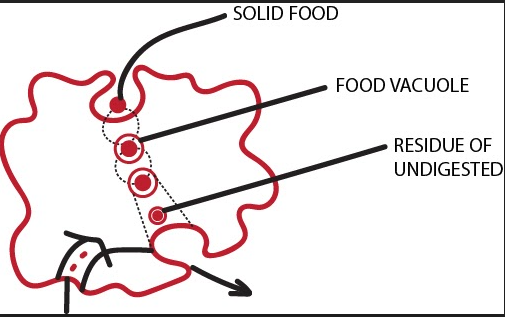
In the diagram, which of the following processes are shown in Amoeba ?

A) Exocytosis
B) Phagocytosis
C) Pinocytosis
D) Both A and B

Answer
510.9k+ views
Hint: A one-celled amoeba, also known as an amoeboid, is a type of cell or unicellular living being that can change its shape by expanding and retracting pseudopods. Amoebae do not have a single scientific classification; rather, they can be found in every significant eukaryotic creature's ancestry.
Complete answer:
A one-celled Amoeba is any of the minuscule unicellular protozoans of the rhizopodial order Amoeboid. It is also spelled single adaptable cell, plural one-celled critters or amoebae. Amoeba proteus, a notable species, is found on rotting base vegetation in freshwater streams and lakes. There are many different parasitic single adaptable cells. Entamoeba histolytica, one of six species found in the human wholesome parcel, causes amoebic diarrhoea. Acanthamoeba and Naegleria are two related free-living genera with growing biomedical significance; strains of both have been identified as infection-causing parasites in a few vertebrates, including humans.
All of the above measurements are shown in the chart by a single adaptable cell.
Exocytosis is the interaction that occurs when undigested build-up is ingested on the outside of the body.
Phagocytosis is the process by which an extracellular unfamiliar molecule or bacterium is ingested and then absorbed. A single adaptable cell accomplishes this by expanding its pseudopodia around the food and completely encircling it with cytoplasm, resulting in the formation of a food vacuole. Food vacuole wires connect to the lysosome, which contains stomach-related chemicals. As absorption progresses, the food vacuole shrinks and the assimilation products diffuse into the cytoplasm.
Pinocytosis (liquid endocytosis or mass stage pinocytosis) is a type of endocytosis in which extracellular liquid or fluid is overwhelmed and brought into the cell by the superficial maturation of small vesicles.
Hence, option B-Phagocytosis is the correct option.
Note:
Single adaptable cells are distinguished by their ability to form transitory cytoplasmic expansions known as pseudopodia, or phantom feet, through which they move. This type of development, known as amoeboid development, is regarded as the most primitive type of creature movement.
Complete answer:
A one-celled Amoeba is any of the minuscule unicellular protozoans of the rhizopodial order Amoeboid. It is also spelled single adaptable cell, plural one-celled critters or amoebae. Amoeba proteus, a notable species, is found on rotting base vegetation in freshwater streams and lakes. There are many different parasitic single adaptable cells. Entamoeba histolytica, one of six species found in the human wholesome parcel, causes amoebic diarrhoea. Acanthamoeba and Naegleria are two related free-living genera with growing biomedical significance; strains of both have been identified as infection-causing parasites in a few vertebrates, including humans.
All of the above measurements are shown in the chart by a single adaptable cell.
Exocytosis is the interaction that occurs when undigested build-up is ingested on the outside of the body.
Phagocytosis is the process by which an extracellular unfamiliar molecule or bacterium is ingested and then absorbed. A single adaptable cell accomplishes this by expanding its pseudopodia around the food and completely encircling it with cytoplasm, resulting in the formation of a food vacuole. Food vacuole wires connect to the lysosome, which contains stomach-related chemicals. As absorption progresses, the food vacuole shrinks and the assimilation products diffuse into the cytoplasm.
Pinocytosis (liquid endocytosis or mass stage pinocytosis) is a type of endocytosis in which extracellular liquid or fluid is overwhelmed and brought into the cell by the superficial maturation of small vesicles.
Hence, option B-Phagocytosis is the correct option.
Note:
Single adaptable cells are distinguished by their ability to form transitory cytoplasmic expansions known as pseudopodia, or phantom feet, through which they move. This type of development, known as amoeboid development, is regarded as the most primitive type of creature movement.
Recently Updated Pages
Master Class 9 Social Science: Engaging Questions & Answers for Success

Master Class 9 Science: Engaging Questions & Answers for Success

Master Class 9 English: Engaging Questions & Answers for Success

Master Class 9 Maths: Engaging Questions & Answers for Success

Master Class 11 Economics: Engaging Questions & Answers for Success

Master Class 11 English: Engaging Questions & Answers for Success

Trending doubts
Which places in India experience sunrise first and class 9 social science CBSE

Fill the blanks with the suitable prepositions 1 The class 9 english CBSE

Write the 6 fundamental rights of India and explain in detail

Difference Between Plant Cell and Animal Cell

What is the Full Form of ISI and RAW

What is pollution? How many types of pollution? Define it





